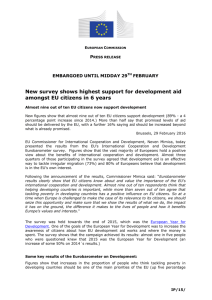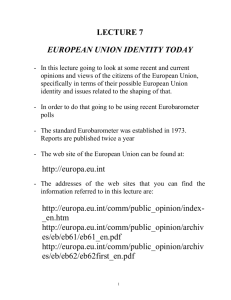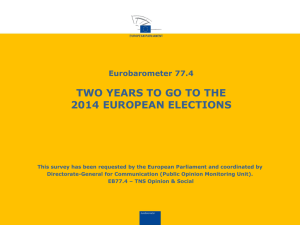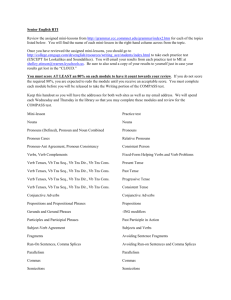EUROBAROMETER 76 FIRST RESULTS PUBLIC OPINION IN THE EUROPEAN UNION Standard Eurobarometer
advertisement
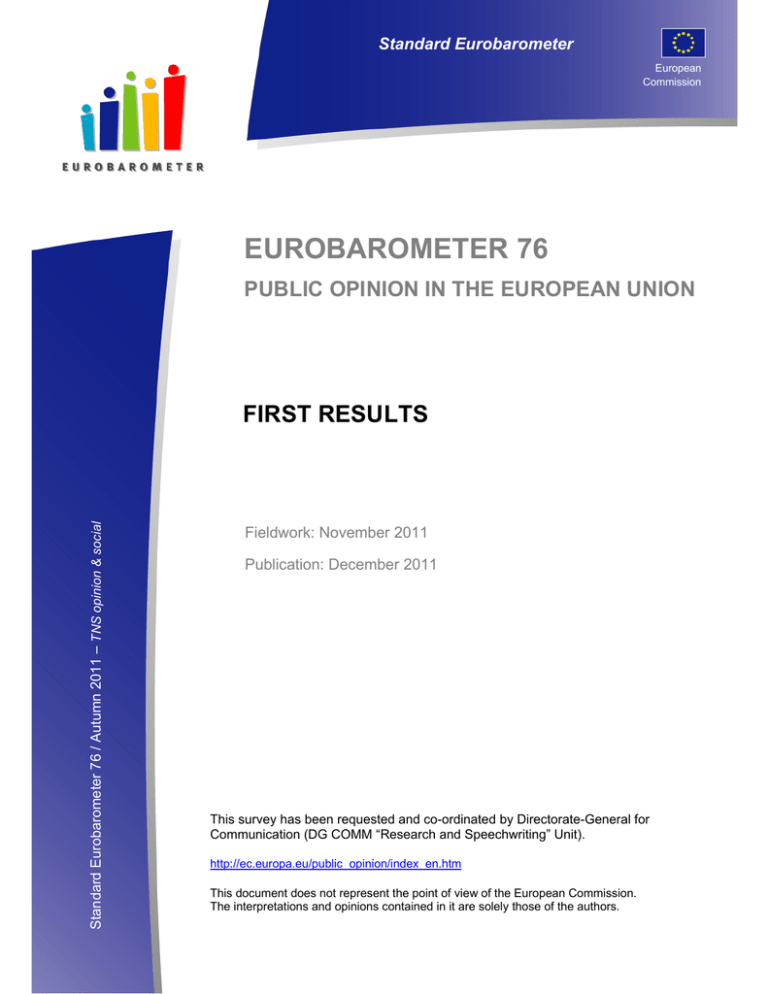
Standard Eurobarometer European Commission EUROBAROMETER 76 PUBLIC OPINION IN THE EUROPEAN UNION Standard Eurobarometer 76 / Autumn 2011 – TNS opinion & social FIRST RESULTS Fieldwork: November 2011 Publication: December 2011 This survey has been requested and co-ordinated by Directorate-General for Communication (DG COMM “Research and Speechwriting” Unit). http://ec.europa.eu/public_opinion/index_en.htm This document does not represent the point of view of the European Commission. The interpretations and opinions contained in it are solely those of the authors. Standard Eurobarometer 76 Autumn 2011 First results Conducted by TNS Opinion & Social at the request of the European Commission Directorate-General for Communication Survey co-ordinated by the Directorate-General for Communication EUROBAROMETER 76 FIRST RESULTS TABLE OF CONTENTS INTRODUCTION................................................................................................. 3 1. THE EUROPEANS AND THE STATE OF THE ECONOMY ...................................... 6 1.1 Assessment of the current situation: general and personal aspects ......... 6 1.2 The household financial situation: national evolutions ............................. 7 1.3 The current situation of the economy at national level: trend .................. 8 1.4 The current situation of the economy at national level: national results ... 9 2. MAIN CONCERNS ......................................................................................... 10 2.1 Main concerns at national level: trend ................................................... 10 2.2 Main concerns at personal level: trend ................................................... 11 2.3 Main concerns at European level: evolution ........................................... 12 2.4 Expectations for the next twelve months: general and personal aspects 13 3. THE CRISIS ................................................................................................. 14 3.1 Support for a European economic and monetary union with a single currency, the Euro: trend ............................................................................. 14 3.2 Impact of the crisis on jobs: trend ......................................................... 15 3.3 Impact of the crisis on jobs: national results ......................................... 16 3.4 Best actors to take actions against the crisis ......................................... 17 3.5 Measures to reform global financial markets.......................................... 18 4. EUROPEANS AND THE POLITICAL INSTITUTIONS ........................................ 19 4.1 Trust in the national government, the national parliament, and the European Union: trend................................................................................. 19 4.2 Image of the EU: trend .......................................................................... 20 4.3 Trust in the European institutions: trend ............................................... 21 OVERALL CONCLUSION ................................................................................ 21 TECHNICAL SPECIFICATIONS ...................................................................... 22 2 EUROBAROMETER 76 FIRST RESULTS Introduction This report presents the first results of the Standard Eurobarometer 76 survey which was carried out from 5 to 20 November 20111. Interviews took place in 33 countries or territories: the 27 European Union Member States, the five candidate countries (Croatia, the Former Yugoslav Republic of Macedonia, Turkey, Iceland and Montenegro), and the Turkish Cypriot Community in the part of the country that is not controlled by the government of the Republic of Cyprus. This "First results" report is a selection of graphics illustrating questions on different themes related to the economy and the political situation. It is published with the results of the Standard Eurobarometer questions on the economic crisis and other political trends in the EU. As in previous surveys, the results show that wide divergences continue to exist between public opinion in different EU Member States, particularly on questions related to the economy. After the improvement in European public opinion observed in the previous survey in Spring 2011 (EB75), the current survey shows that the results of Europeans' appraisal of their own household and job situations remain relatively stable. However there has been a marked deterioration in optimism about the evaluation of the current state of the European economy and about future economic prospects at national, European and global level. There is also a sharp decline in trust in both national and European political institutions. However, despite the difficulties encountered and a less positive image, Europeans still see the EU as the institution best able to take effective measures to tackle the crisis. The survey has been conducted in a period when EU-related issues have been prominent in the media. The fieldwork started after the European Councils of 23 and 26 October and against the immediate backdrop of the G20 meeting in Cannes on 3-4 November. It is important to note that during the fieldwork period, new Prime Ministers were appointed in Greece (10 November) and Italy (16 November). It also coincided with preparations in Spain for the general election (20 November). At the start of the fieldwork, the Commission published its Autumn economic forecasts2 for 2012, cutting GDP predictions to 0,5% in the euro area, and 0,6% in the EU as a whole. The fieldwork ended on 20 November, well before the European Council of 8-9 December which took further steps to improve economic governance in the European Union3 4. 1 2 3 4 For precise details of the fieldwork dates in each country, please refer to the technical specifications. http://ec.europa.eu/economy_finance/publications/european_economy/2011/pdf/ee-2011-6_en.pdf http://www.consilium.europa.eu/uedocs/cms_data/docs/pressdata/en/ec/126714.pdf http://www.consilium.europa.eu/uedocs/cms_data/docs/pressdata/en/ec/126658.pdf 3 EUROBAROMETER 76 FIRST RESULTS This report focuses on results from the EU27 Member States and is divided into four parts. The first focuses on the way Europeans perceive the current economic situation; the second addresses the main concerns of Europeans, and their expectations for the next twelve months; the report then turns to the euro and issues linked to the crisis. Finally, the fourth part is devoted to the appraisal of political institutions: national governments and parliaments, and the EU and its institutions. These questions have been asked in previous Standard Eurobarometer surveys, and trend results are presented. * * * The methodology used is that of the Standard Eurobarometer surveys of the DirectorateGeneral for Communication (“Research and Speechwriting” Unit). A technical note concerning the interviews, carried out by the institutes within the TNS Opinion & Social network, is annexed to this report. This note describes the interview method used, as well as the confidence intervals5. The Eurobarometer web site can be consulted at the following address: http://ec.europa.eu/public_opinion/index_en.htm We wish to thank the people throughout Europe who have given their time to take part in this survey. Without their active participation, this survey would not have been possible. * * * 5 The results tables are included in the annex. It should be noted that the total of the percentages in the tables of this report may exceed 100% when the respondent can give several answers to the same question. 4 EUROBAROMETER 76 FIRST RESULTS Note: In this report, the countries are represented by their official abbreviations. The abbreviations used in this report correspond to: ABBREVIATIONS EU27 European Union – 27 Member States DK/NA Don’t know / No answer BE BG CZ DK DE EE EL ES FR IE IT CY LT LV LU HU MT NL AT PL PT RO SI SK FI SE UK Belgium Bulgaria Czech Republic Denmark Germany Estonia Greece Spain France Ireland Italy Republic of Cyprus* Area not controlled by the government of the Republic of Cyprus Lithuania Latvia Luxembourg Hungary Malta The Netherlands Austria Poland Portugal Romania Slovenia Slovakia Finland Sweden The United Kingdom HR TR MK IS ME Croatia Turkey The Former Yugoslav Republic of Macedonia** Iceland Montenegro CY (tcc) * Cyprus as a whole is one of the 27 European Union Member States. However, the “acquis communautaire” is suspended in the part of the country that is not controlled by the government of the Republic of Cyprus. For practical reasons, only the interviews conducted in the part of the country controlled by the government of the Republic of Cyprus are recorded in the category “CY” and included in the EU27 average. The interviews conducted in the part of the country not controlled by the government of the Republic of Cyprus are recorded in the category “CY(tcc)” [tcc: Turkish Cypriot Community]. ** Provisional code which does not prejudge in any way the definitive nomenclature for this country, which will be agreed following the conclusion of negotiations currently taking place at the United Nations. Results for CY(tcc), HR, TR, MK, IS and ME are available in the Annex to this report providing the data tables. 5 EUROBAROMETER 76 FIRST RESULTS 1. The Europeans and the state of the economy 1.1 Assessment of the current situation: general and personal aspects Overall, people's assessments of their current household financial situation and of their own job situation have shown a measurable but slight decline over the last six months (both -4 points). There has been a much more marked deterioration in positive appraisals of the economic situation at European level (-12 points) and at world level (-7 points). 6 EUROBAROMETER 76 FIRST RESULTS 1.2 The household financial situation: national evolutions Taking the aggregate results across all 27 Member States, more than six in ten Europeans (61%) still say the current financial situation of their household is good. This indicator has been relatively stable over the last year: compared to Autumn 2010 (EB 74), it has lost only three percentage points. However, it is important to note that only a minority think their household financial situation is good in six countries: Lithuania, Romania, Portugal, Bulgaria, Hungary and Greece. 7 EUROBAROMETER 76 FIRST RESULTS 1.3 The current situation of the economy at national level: trend The historical trend depicts the continuity of the results recorded in Autumn 2011 for the current situation of the national economy. These are the aggregate results at EU level of public opinion in all the EU Member States. Around 7 in 10 Europeans continue to think that the situation of their national economy is rather bad or very bad. It is nevertheless important to note that the positive answers are still percentage 8 points above the most recent low recorded in Spring 2009. 8 EUROBAROMETER 76 FIRST RESULTS 1.4 The current situation of the economy at national level: national results Differentiation between public opinion in the EU Member States on this question remains wide. Behind the EU average, there is still a difference of around 80 percentage points between the highest and lowest results for those who say that the economic situation of their country is good. In some Member States - for example, Sweden, Luxembourg and Germany - around 80% or more of people judge the situation of the national economy to be good. However, in other countries – for example, Greece, Ireland and Spain – fewer than 5% of people take this view. 9 EUROBAROMETER 76 FIRST RESULTS 2. Main concerns 2.1 Main concerns at national level: trend At national level, unemployment and the economic situation are now equally seen as the two most important concerns of Europeans. The snapshot of public opinion on this issue in Autumn 2011 is rather similar to the one recorded in January 2009. 10 EUROBAROMETER 76 FIRST RESULTS 2.2 Main concerns at personal level: trend The results of the question about concerns at a personal level are more stable. However, there was a significant rise in the number of respondents who see the economic situation among the top two issues which they face (+5 points). 11 EUROBAROMETER 76 FIRST RESULTS 2.3 Main concerns at European level: evolution Europeans clearly see the economic situation emerging once again as the most important issue for the European Union (+16 points). Perhaps understandably, the public finances of the Member States have also risen in importance in the minds of Europeans and are now the second most important issue (+9 points), followed by unemployment. Inflation is among the two most important issues facing the EU for fewer than one in five – unchanged since the Spring. Over the same period, the relative importance of immigration has declined (-11 points). 12 EUROBAROMETER 76 FIRST RESULTS 2.4 Expectations for the next twelve months: general and personal aspects Despite relatively turbulent times since the last Standard Eurobarometer was conducted in Spring 2011, people's outlook for their household and personal job situations has remained relatively stable. The aggregate results across the 27 Member States show three in four Europeans feel the next 12 months will be the same or better. There has been a rise in those who feel it will be worse. However, people's expectations for the economy over the next twelve months have become markedly more pessimistic. This applies at national, European and global levels. The proportion who feel the next twelve months will be worse has risen by 16, 19 and 16 percentage points respectively. 13 EUROBAROMETER 76 FIRST RESULTS 3. The crisis 3.1 Support for a European economic and monetary union with a single currency, the Euro: trend Public support for the Euro remains solid despite a slight deterioration over time. As we approach the 10th anniversary of the introduction of Euro notes and coins, it is important to note that public support for the single currency remains stable. The results presented below are those for the European Union. In the Euro area, the support for the Euro reaches 64% with only 29% against. 14 EUROBAROMETER 76 FIRST RESULTS 3.2 Impact of the crisis on jobs: trend There had been a slow but steady rise over the 2 years to Spring 2011 in the proportion of Europeans who consider the impact of the crisis on jobs has already reached its peak. Equally, there had been a slow but steady decline in those feeling the worst is still to come. However, since Spring 2011, Europeans' outlook on this question has turned significantly more pessimistic. 68% (+21 points since Spring 2011) of Europeans say that when it comes to the impact of the economic crisis on jobs, "the worst is still to come". 15 EUROBAROMETER 76 FIRST RESULTS 3.3 Impact of the crisis on jobs: national results Here the differentiation between public opinion across EU Member States is less marked. From Estonia (40%) to Portugal (11%), those who feel the crisis has reached its peak are not yet in the majority. The aggregate of public opinion in Europe shows that Europeans feel the worst of the crisis is still to come. 16 EUROBAROMETER 76 FIRST RESULTS 3.4 Best actors to take actions against the crisis Despite their more pessimistic outlook, Europeans see the European Union as the actor best able to take effective action against the financial and economic crisis. This result remains stable - the EU is still seen as part of the solution to the crisis. 17 EUROBAROMETER 76 FIRST RESULTS 3.5 Measures to reform global financial markets Public support for the measures proposed in the questionnaire related to global financial market reform remains steady. The aggregate results show that almost 2 in 3 Europeans support the introduction of a tax on financial transactions (proposed by the European Commission President in his State of the Union Address on 28 September 20116). Three quarters of Europeans support tighter rules for credit rating agencies (reforms were proposed by the European Commission on 15 November 2011). There is less clarity on the "Eurobonds" issue: 44% are in favour, 24% opposed and 32% do not know. The European Commission published its Green paper on Stability Bonds on 23 November 2011. 6 http://ec.europa.eu/commission_2010-2014/president/state-union-2011/index_en.htm 18 EUROBAROMETER 76 FIRST RESULTS 4. Europeans and the political institutions 4.1 Trust in the national government, the national parliament, and the European Union: trend The past six months has seen a further erosion of trust in political institutions in general. This has affected national Governments and national Parliaments in the EU Member States (aggregate -8 and -6 points respectively) as well as the European Union (-7 points). 19 EUROBAROMETER 76 FIRST RESULTS 4.2 Image of the EU: trend Perhaps not surprisingly, the proportion of the public saying the EU conjures up a positive image has suffered a sharp decline since Spring 2011 (-9 points). The aggregate results for those with a neutral or negative image of the EU both rose (+3 points and +6 points respectively). 20 EUROBAROMETER 76 FIRST RESULTS 4.3 Trust in the European institutions: trend Like national political institutions, trust in the four main EU institutions (Parliament, Commission, Council and European Central Bank) has following a downward trend since Autumn 2009. The aggregate result is that fewer people tend to trust the European Institutions than tend to distrust them. OVERALL CONCLUSION This report is published with the data for the "Standard" Eurobarometer questions about the economic crisis and about the general political situation in the European Union. People's views of their own situation and that of their country's economy have remained relatively stable. However, there is a marked downward shift in public perception of the European economy. Moreover, there is a decline in optimism about prospects for the next 12 months. Over the same six month time period, there has been a sharp decline in trust in political institutions both at national level and also at European level. Yet despite this, the EU remains the actor which Europeans feel will be most effective in tackling the economic crisis. 21 EUROBAROMETER 76 FIRST RESULTS TECHNICAL SPECIFICATIONS STANDARD EUROBAROMETER 76 First results TECHNICAL SPECIFICATIONS Between the 5th of November and the 20th of November 2011, TNS Opinion & Social, a consortium created between TNS plc and TNS opinion, carried out the wave 76.3 of the EUROBAROMETER, on request of the EUROPEAN COMMISSION, Directorate-General for Communication, “Research and Speechwriting”. The EUROBAROMETER 76.3 is a "STANDARD EUROBAROMETER" and covers the population of the respective nationalities of the European Union Member States, resident in each of the Member States and aged 15 years and over. The STANDARD EUROBAROMETER 76 has also been conducted in the five candidate countries (Croatia, Turkey, the Former Yugoslav Republic of Macedonia, Iceland and Montenegro) and in the Turkish Cypriot Community. In these countries, the survey covers the national population of citizens and the population of citizens of all the European Union Member States that are residents in these countries and have a sufficient command of the national languages to answer the questionnaire. The basic sample design applied in all states is a multi-stage, random (probability) one. In each country, a number of sampling points was drawn with probability proportional to population size (for a total coverage of the country) and to population density. In order to do so, the sampling points were drawn systematically from each of the "administrative regional units", after stratification by individual unit and type of area. They thus represent the whole territory of the countries surveyed according to the EUROSTAT NUTS II (or equivalent) and according to the distribution of the resident population of the respective nationalities in terms of metropolitan, urban and rural areas. In each of the selected sampling points, a starting address was drawn, at random. Further addresses (every Nth address) were selected by standard "random route" procedures, from the initial address. In each household, the respondent was drawn, at random (following the "closest birthday rule"). All interviews were conducted face-to-face in people's homes and in the appropriate national language. As far as the data capture is concerned, CAPI (Computer Assisted Personal Interview) was used in those countries where this technique was available. 22 EUROBAROMETER 76 ABBR. FIRST RESULTS N° INTERVIEWS COUNTRIES INSTITUTES BE BG CZ DK DE EE IE EL ES FR IT CY LV LT LU HU MT NL Belgium Bulgaria Czech Rep. Denmark Germany Estonia Ireland Greece Spain France Italy Rep. of Cyprus Latvia Lithuania Luxembourg Hungary Malta Netherlands AT Austria TNS Dimarso TNS BBSS TNS Aisa TNS Gallup DK TNS Infratest Emor Ipsos MRBI TNS ICAP TNS Demoscopia TNS Sofres TNS Infratest Synovate TNS Latvia TNS Gallup Lithuania TNS ILReS TNS Hoffmann Kft MISCO TNS NIPO Österreichisches Gallup-Institut TNS OBOP TNS EUROTESTE TNS CSOP RM PLUS TNS Slovakia TNS Gallup Oy TNS GALLUP TNS UK PL PT RO SI SK FI SE UK TOTAL EU27 CY(tcc) HR TR MK IS ME TOTAL Poland Portugal Romania Slovenia Slovakia Finland Sweden United Kingdom Turkish Cypriot Community Croatia Turkey Former Yugoslav Rep. of Macedonia Iceland Montenegro 20/11/2011 14/11/2011 20/11/2011 20/11/2011 20/11/2011 20/11/2011 18/11/2011 18/11/2011 20/11/2011 20/11/2011 20/11/2011 20/11/2011 20/11/2011 20/11/2011 20/11/2011 20/11/2011 20/11/2011 20/11/2011 20/11/2011 8.866.411 6.584.957 8.987.535 4.533.420 64.545.601 916.000 3.375.399 8.693.566 39.035.867 47.620.942 51.252.247 651.400 1.448.719 2.849.359 404.907 8.320.614 335.476 13.288.200 1.001 1.000 1.002 1.011 1.017 1.000 1.002 1.022 1.312 05/11/2011 05/11/2011 05/11/2011 05/11/2011 05/11/2011 05/11/2011 05/11/2011 05/11/2011 20/11/2011 20/11/2011 20/11/2011 19/11/2011 20/11/2011 20/11/2011 20/11/2011 20/11/2011 32.306.436 8.080.915 18.246.731 1.748.308 4.549.954 4.412.321 7.723.931 51.081.866 26.594 05/11/2011 20/11/2011 05/11/2011 16/11/2011 05/11/2011 05/11/2011 20/11/2011 20/11/2011 3.749.400 52.728.513 1.678.404 500 Puls TNS PIAR 1.000 1.001 TNS Brima 1.056 05/11/2011 12/11/2011 500 1.008 31.659 05/11/2011 05/11/2011 05/11/2011 20/11/2011 20/11/2011 20/11/2011 Capacent TNS Medium Gallup POPULATION 15+ 05/11/2011 05/11/2011 05/11/2011 05/11/2011 05/11/2011 05/11/2011 05/11/2011 05/11/2011 05/11/2011 05/11/2011 07/11/2011 05/11/2011 05/11/2011 05/11/2011 05/11/2011 05/11/2011 05/11/2011 05/11/2011 05/11/2011 1.028 1.003 1.002 1.009 1.538 1.003 1.015 1.000 1.004 1.031 1.031 504 1.009 1.026 498 1.021 500 1.005 Kadem FIELDWORK DATES 6.973.277 406.834.359 143.226 252.277 492.265 469.946.984 For each country a comparison between the sample and the universe was carried out. The Universe description was derived from Eurostat population data or from national statistics offices. For all countries surveyed, a national weighting procedure, using marginal and intercellular weighting, was carried out based on this Universe description. In all countries, gender, age, region and size of locality were introduced in the iteration procedure. For international weighting (i.e. EU averages), TNS Opinion & Social applies the official population figures as provided by EUROSTAT or national statistic offices. The total population figures for input in this post-weighting procedure are listed above. Readers are reminded that survey results are estimations, the accuracy of which, everything being equal, rests upon the sample size and upon the observed percentage. With samples of about 1,000 interviews, the real percentages vary within the following confidence limits: Observed percentages 10% or 90% 20% or 80% 30% or 70% 40% or 60% 50% Confidence limits ± 1.9 points ± 2.5 points ± 2.7 points ± 3.0 points ± 3.1 points 23
